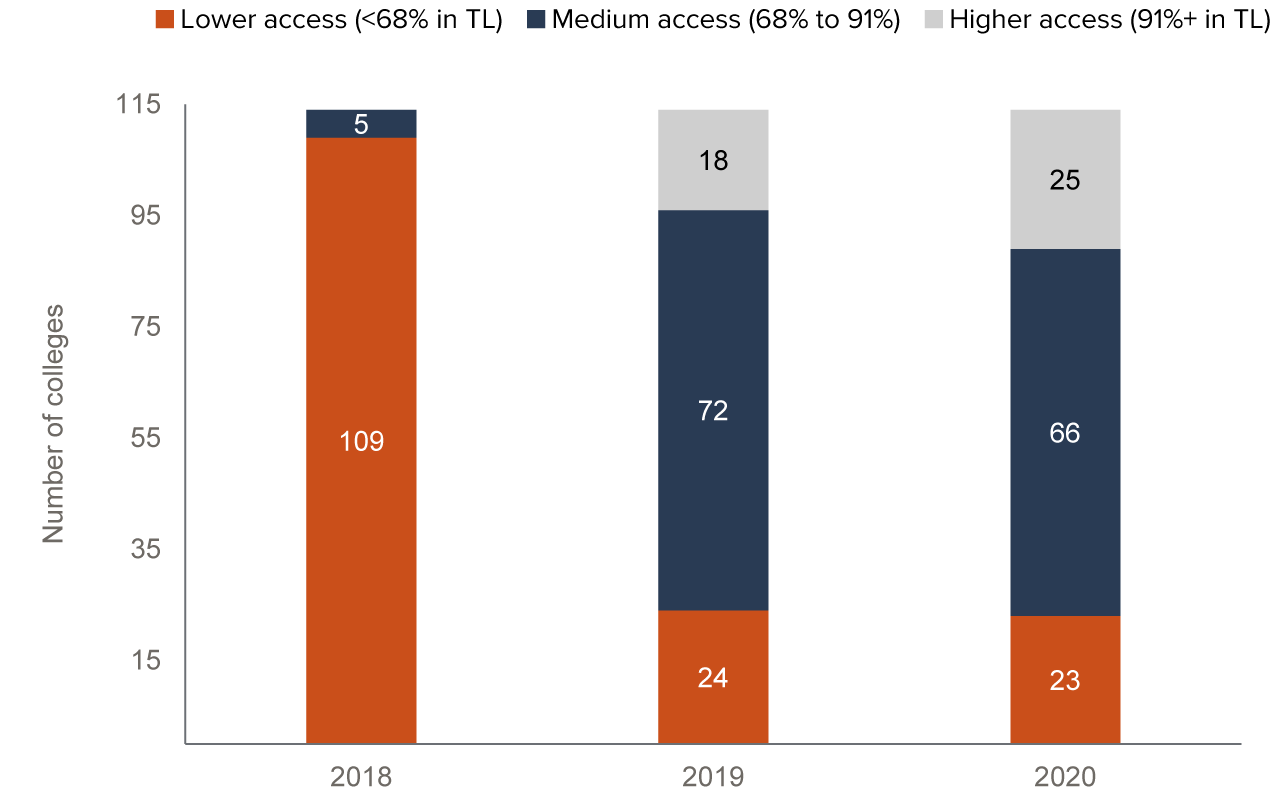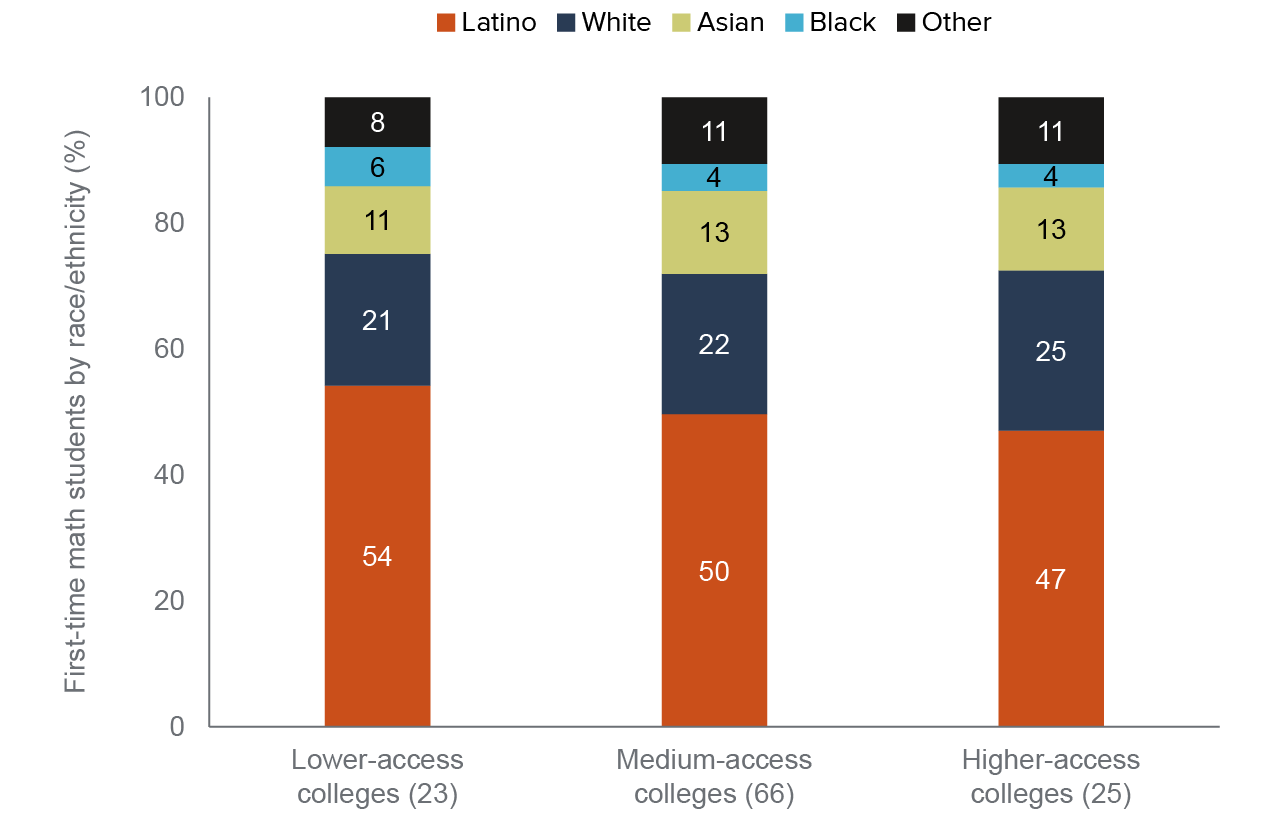Table of Contents
- Key Takeaways
- Introduction
- The Pandemic and AB 705
- Some Colleges Still Require or Allow Students to Enroll in BTL Courses
- AB 705 and the BSTEM Path
- Reducing Racial and Ethnic Gaps in Success
- Caveats and Limitations
- Conclusion and Recommendations
- Glossary of Terms
- Notes and References
- Authors and Acknowledgments
- PPIC Board of Directors
- Copyright
Key Takeaways
California’s community colleges first began implementing Assembly Bill 705 (AB 705) in fall 2019, making major reforms to assess and place students away from pre-requisite remediation courses for English and math and into transfer-level courses. In this report, we examine the progress colleges and students have made around transfer-level math courses through fall 2020.
- Colleges continued to implement AB 705 in the face of COVID-19, and rates of students enrolling directly into gateway math held steady. The rate of students passing these courses increased. The share of first-time math students completing transfer-level math in one term rose from 40 percent in fall 2019 to 46 percent in fall 2020, far higher than before AB 705 (24% in fall 2018). →
- However, a substantial number of students are still required or allowed to enroll in below transfer-level courses. At one in five colleges, a third or more of students are enrolled in such courses. When access to transfer-level courses is restricted or discouraged, Black and Latino students are more likely to end up in below transfer-level courses. Moreover, the chances of completing a transfer-level course are significantly diminished for those who start in a course below transfer-level: only a third of these students subsequently enrolled in a transfer-level course and a fifth successfully completed it as of the next fall. →
- Students pursuing majors in business and STEM (BSTEM)—about 36 percent of first-time math students who intended to transfer—are now more likely to take a math course that is appropriate for their intended major and consequently more likely to successfully complete calculus, which is the gateway course for these majors. About one in four first-time students pursuing a BSTEM major in the fall 2019 cohort successfully completed Calculus I or Applied Calculus as of the next fall. This rate is 22 percent higher than for the fall 2018 cohort. →
- To increase the number of students enrolling directly into transfer-level math courses, colleges should enroll transfer-intending students into transfer-level courses by default. To direct students to the appropriate math pathways based on intended majors, counselors, advisors, and faculty could work together to ensure a common understanding of course offerings and placement policies. Equity must be at the forefront of practice and policy, from messaging to student supports to course design. →
Introduction
Starting in fall 2019, Assembly Bill 705 completely reshaped how California community colleges placed and remediated students. This law sought to dramatically reduce the number of students placed in remedial English and math courses, which had been a major barrier to students achieving their academic goals and had driven profound racial inequities in access to transfer-level courses.
AB 705 required community colleges to implement changes that would maximize students’ likelihood of starting and completing transfer-level (or degree-appropriate) coursework in English and math/quantitative reasoning within one year. Under the law, colleges must use high school information (e.g., GPA, coursework, and/or grades in specific math/English courses) as the primary criteria for placement recommendations.
As a result, students gained access to transfer-level English and math courses on a scale difficult to imagine just a few years ago. In fall 2019, almost all students enrolled in college composition, and more than three in four students enrolled directly in transfer-level math. This is a staggering change: compared to fall 2015, access rates have more than doubled in English and more than tripled in math.
Increased access has substantially affected successful completion of gateway, transfer-level courses—a key educational milestone. About 57,000 more first-time English students successfully completed college composition with a C or better in fall 2019 than in fall 2015, and roughly 31,000 more students passed gateway math. Altogether, 61 percent of first-time English students and 40 percent of first-time math students met this milestone in fall 2019—in both cases, more than double the number in fall 2015.
Importantly, the system made great strides in eliminating longstanding racial inequities. Racial equity gaps in access to college composition were virtually eliminated and they narrowed significantly in transfer-level math (Cuellar Mejia, Rodriguez, and Johnson 2020; RP Group 2021, Melguizo et al. 2021). Even with this extraordinary progress, the work is not over. Latino students and especially Black students continue to see lower completion rates than their Asian and white peers, especially for math. Moreover, thousands of students are still required or allowed to enroll in below transfer-level math courses, which reduces their chances of successfully completing a transfer-level course (Hayward 2021) and raises questions about whether colleges are maximizing the chance for students to complete a transfer-math course within a year.
Two years since California implemented AB 705 statewide, advocacy groups, policy researchers, academia, student groups, the philanthropic sector, and racial equity experts have continued to engage in this arena to ensure that colleges implement the law with fidelity and racial equity, and that the legislature’s objectives are met.
For this report, we rely on longitudinal student-level data provided by the California Community Colleges Chancellor’s Office (this data covers the universe of students enrolled across all the colleges in the system) to examine how AB 705 has continued to play out as of fall 2020. We focus on math because implementing AB 705 in math has been more challenging than in English. At many colleges, a high share of first-time math students are still required or allowed to start in below transfer-level math courses, and large racial equity gaps in successful completion remain. A report to be released in the spring will focus on parallel results for English. We restrict our analyses to first-time math students because with these students we can do a more direct comparison of student outcomes before and after AB 705 implementation. In addition, when we evaluate outcomes beyond one term, we focus primarily on transfer-intending students (about 72% of first-time math students).
This report builds on our previous research and sheds light on how students were faring under the new placement structures and concurrent academic supports as of fall 2020. First, we examine how the pandemic affected implementation of AB 705. Next, we examine enrollments and outcomes in below transfer-level courses and assess how BSTEM students from the fall 2019 cohort have fared beyond their initial outcomes. We then report on strategies colleges have used to reduce racial inequality over the first two years of AB 705 implementation. We conclude with recommendations derived from our research.
We also consider the role of corequisite remediation in improving student outcomes. Corequisite remediation—a curricular model where students enroll directly into the gateway transfer-level course and receive academic support concurrently—has been a key component of how colleges implement AB 705. Students who take transfer-level math and a corequisite course are far more likely to complete transfer-level math than students who start in pre-requisite remediation, or below transfer-level.
However, questions remain about how to design and target corequisites. For example, more research is still needed to determine how much of the gain in successful completion is because students are receiving effective corequisite support, how much is because students are able to enroll in the transfer course that best fits their program of study, and how much is simply the result of direct access to the transfer-level course. The complexities in a system as big and heterogeneous as the California Community Colleges make answering these questions challenging. For example, corequisite courses come in many forms, and placement policies for corequisite courses vary across the system (Cuellar Mejia, Rodriguez, and Johnson 2020). Even though data constraints limit our ability to attribute causality to corequisite courses, in Technical Appendix E, we discuss preliminary findings that could shed light and guide future research.
The Pandemic and AB 705
The COVID-19 pandemic hit as colleges were in the midst of the second academic term of AB 705 implementation, affecting one-year outcomes for the fall 2019 cohort and outcomes for a new cohort of first-time math students. Our previous research offered early insights into how colleges responded to pandemic challenges. Here, we compare outcomes for students who took their first math course in fall 2020, during the pandemic, to those who did so in pre-pandemic fall 2019. While this section centers on comparing fall 2019 and 2020 cohorts, most figures here cover earlier cohorts as well. We do so to contextualize changes brought on by the pandemic.
Rates of Enrollment into Transfer-Level Math Held Steady
From fall 2019 to fall 2020, the share of first-time math students who started in a transfer-level course remained practically unchanged (80% vs. 78%; Figure 1). Importantly, enrollment rates across all racial groups held steady: 85 percent for Asian students, 82 percent for white students, 78 percent for Latino students, and 73 percent for Black students (see Technical Appendix Figure B2).
Direct enrollment into transfer-level courses varied widely at the college level: 62 colleges saw increases, 40 saw declines, and 10 saw no change. In most colleges, changes were relatively modest, but a few saw notable changes. For example, 5 colleges saw a two-digit increase in the number of students going into transfer-level math despite there being fewer first-time math takers (see Technical Appendix Figure B3).
At the other end of the spectrum, 7 colleges experienced a double-digit drop in the share of students going into transfer-level math between fall 2019 and fall 2020. At these colleges, more students started in below transfer-level (BTL) math courses, even more than doubling in the case of 2 colleges. In all, 34 colleges saw increases in the number of first-time math students going into BTL courses, and in 21 of those colleges the increase was equivalent to 20 or more additional students (see Technical Appendix Table B1).
Systemwide access to transfer-level courses did not change during the pandemic
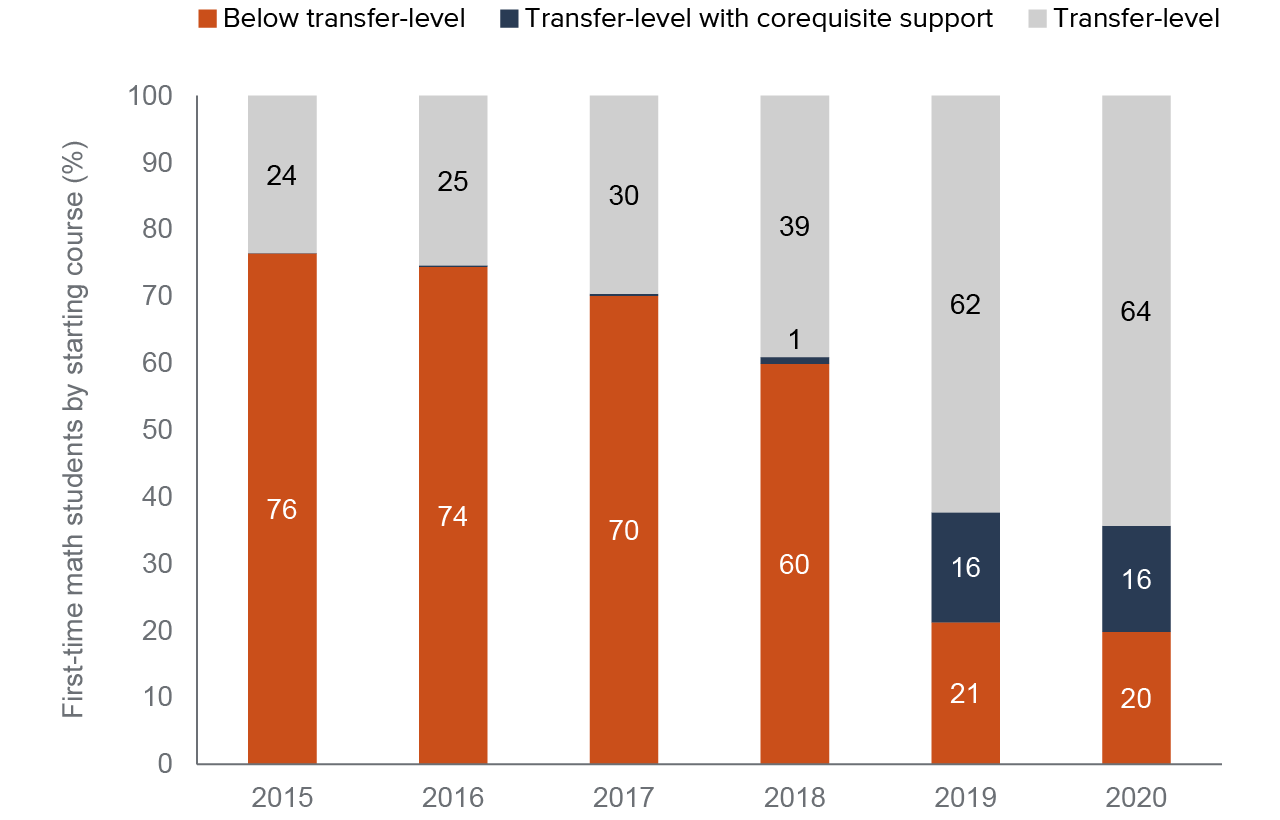
SOURCE: Authors’ calculations using MIS data.
NOTE: Fall of each year. Transfer-level with corequisite support or “corequisite model” means that the students started directly in a transfer-level course with concurrent academic support. In most colleges, the corequisite model means that students enroll in designated sections of the transfer-level course as well as in a one- to three-unit support course. Oftentimes the two courses are linked, meaning that all students in the designated sections take the corequisite support course. In a few colleges, students receive the additional support by enrolling in a higher-unit version of the transfer-level course. Refer to Technical Appendix Figure B1 for the size of each cohort.
First-time math enrollment still fell in fall 2020
There were fewer first-time math students in fall 2020 than in fall 2019, a decline that mostly reflected a lower number of first-time credit, transfer-intending students. Indeed, the decrease in first-time math students was less pronounced (9%) than in the overall transfer-intending cohort (17%), mostly because first-time math enrollment did not fall as much among continuing students. While 16 percent fewer first-time math students were in their first term, 3 percent fewer first-time math students were continuing students (Figure 2). Thus, the pandemic seems to have had a larger effect on overall enrollment than on enrollment in math.
The decline in first-time math enrollment was not a new trend: indeed, 11 percent fewer students took a math course for the first time in fall 2019 than in fall 2018. Students delaying math enrollment likely drove this decline. The number of first-time credit students who declared a transfer goal—or about 60 percent of all new students taking credit courses—is a proxy for the pool of students most likely to take a math course at some point in their college journey. Among these students, 53 percent took a math course in their first term in fall 2018 (pre-AB 705) compared to 46 percent of students in fall 2019 and fall 2020 (see Technical Appendix Figures B4 and B5).
First-time math enrollment declined less among continuing students than new students
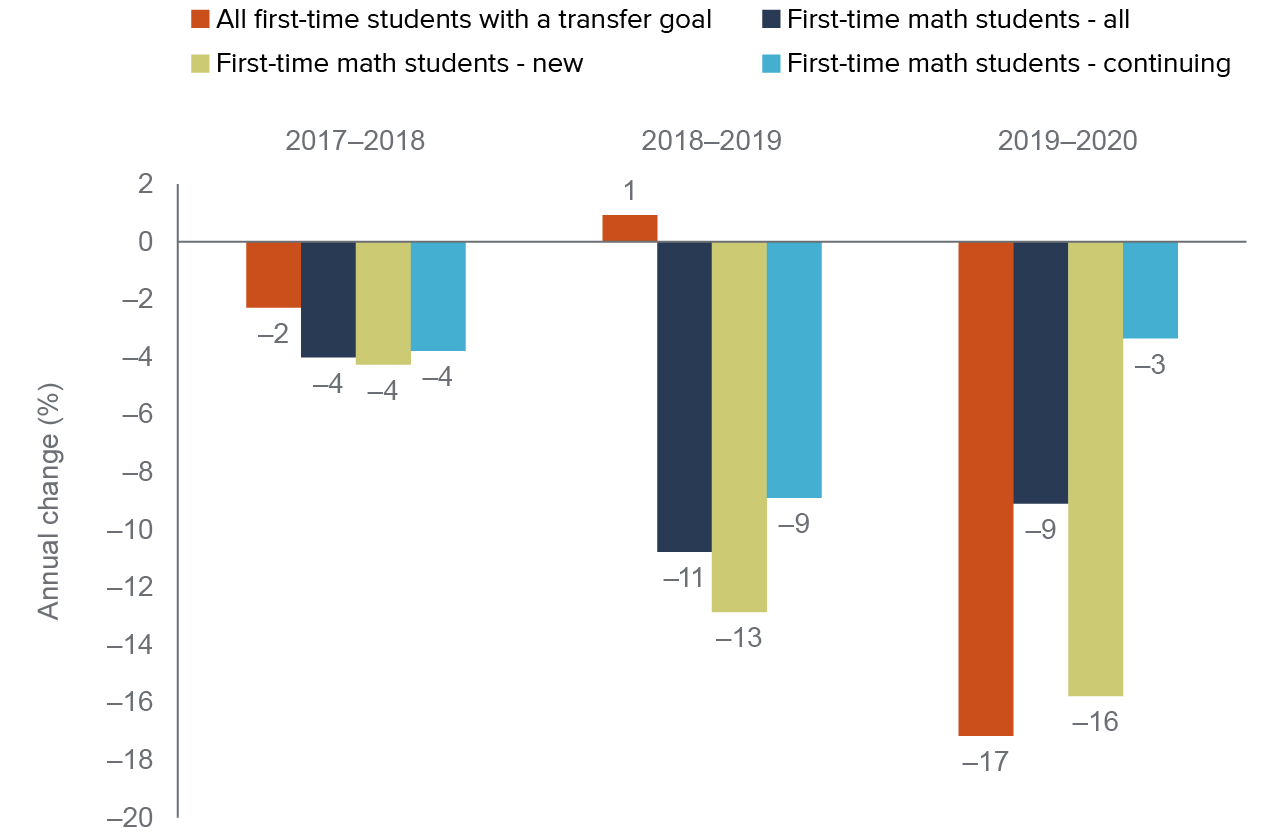
SOURCE: Authors’ calculations using MIS data.
NOTE: Fall-to-fall annual changes. First-time math students-new are students who took their first math course on their first term in the CCC system. First-time math students-continuing are students who were enrolled at least one term at the CCC system prior to taking their first math course.
Enrollment in BSTEM and SLAM courses fell slightly during the pandemic
In terms of math pathways, first-time enrollment into statistics and liberal arts math courses (SLAM) declined less than into algebra-based courses (BSTEM), at 4 percent versus 12 percent (Figure 3). Consequently, the share of students starting in SLAM courses increased by 3 percentage points between 2019 and 2020 (Figure 4). The drop in BSTEM course enrollment could be related to students’ perception of how difficult these courses may be in the online setting. Enrollment in BTL courses fell even more, a signal that colleges continued to implement AB 705 during the pandemic.
The increase was larger among Asian students who, pre-pandemic, were more likely to start in a BSTEM course than in a SLAM course (44% vs. 40%), however, post-pandemic, this situation reversed (41% vs. 44%). This is consistent with the fact that the share of first-time Asian students pursuing BSTEM majors declined 4 percentage points between fall 2019 and fall 2020. In addition, some students in BSTEM majors may be taking statistics first, which is a required course in many of these majors. Among the other racial and ethnic groups, no significant changes occurred in the distribution of students into BSTEM and non-BSTEM majors.
First-time enrollment in SLAM courses declined less than in BSTEM courses in 2020
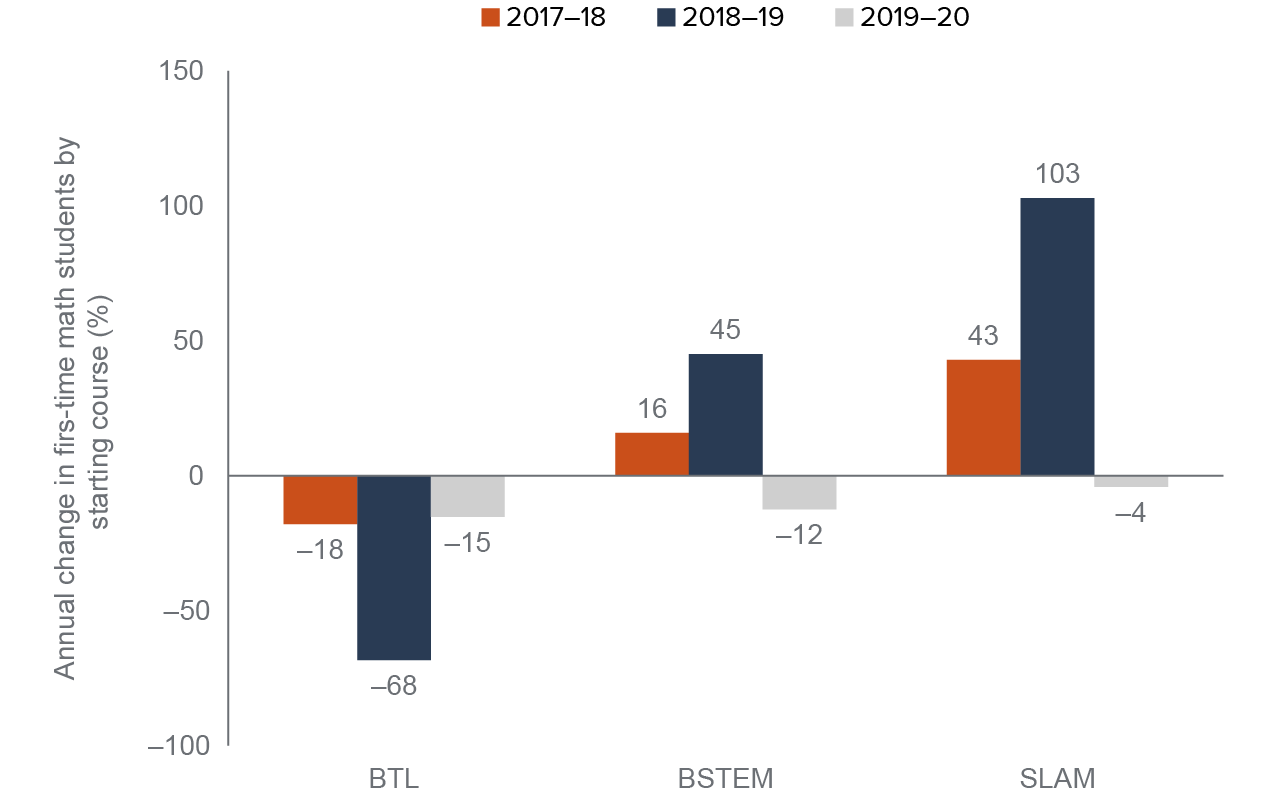
SOURCE: Authors’ calculations using MIS data.
NOTES: Fall-to-fall annual changes. SLAM includes statistics offered in any department, liberal arts math, math for teachers, and quantitative reasoning. BSTEM includes Calculus I, finite math, college algebra, pre-calculus, trigonometry, and applied calculus (i.e., calculus for business, social sciences, behavioral sciences, management, life sciences, and economics). BTL stands for below transfer-level courses and includes intermediate algebra and remedial math courses.
Half of first-time math takers in fall 2020 enrolled in a SLAM course

SOURCE: Authors’ calculations using MIS data.
NOTES: Fall of each year. SLAM includes statistics offered in any department, liberal arts math, math for teachers, and quantitative reasoning. BSTEM includes Calculus I, finite math, college algebra, pre-calculus, trigonometry, and applied calculus (i.e., calculus for business, social sciences, behavioral sciences, management, life sciences, and economics). BTL stands for below transfer-level courses and includes intermediate algebra and remedial math courses. For reference, in fall 2020, there were 64,368 students starting in a SLAM course; 38,642 students starting in a BSTEM course; and 25,461 students starting in a BTL course.
First-time math enrollment in corequisite courses shifted
In fall 2020, enrollment in corequisite courses among first-time math students was 12 percent lower than in fall 2019, at 20,373 students. This decline is somewhat higher than the overall decline for first-time math takers (9%). Still, corequisite students were 16 percent of all first-time math students and 20 percent of those who started in a transfer-level math course (same proportions as in fall 2019). In fall 2020, Black and Latino students were overrepresented among students starting in corequisite models relative to their representation in the total number of first-time math students (see Technical Appendix Table B2).
The prevalence of corequisite models varied widely across colleges. Seventeen colleges did not offer a corequisite math course in any subject, while at 10 colleges more than 40 percent of first-time math students started in a transfer-level course with corequisite support (see Technical Appendix Table B3). Due to availability across colleges and to student demand, the proportion of first-time math students starting in corequisite models varies across subjects. In terms of availability, while 92 colleges offered corequisite support for statistics, 48 colleges did so for college algebra, 35 colleges for trigonometry, 26 college for applied calculus, 25 colleges for pre-calculus and 17 colleges for liberal arts math (see Figure 5).
The availability of corequisite support varies across subjects
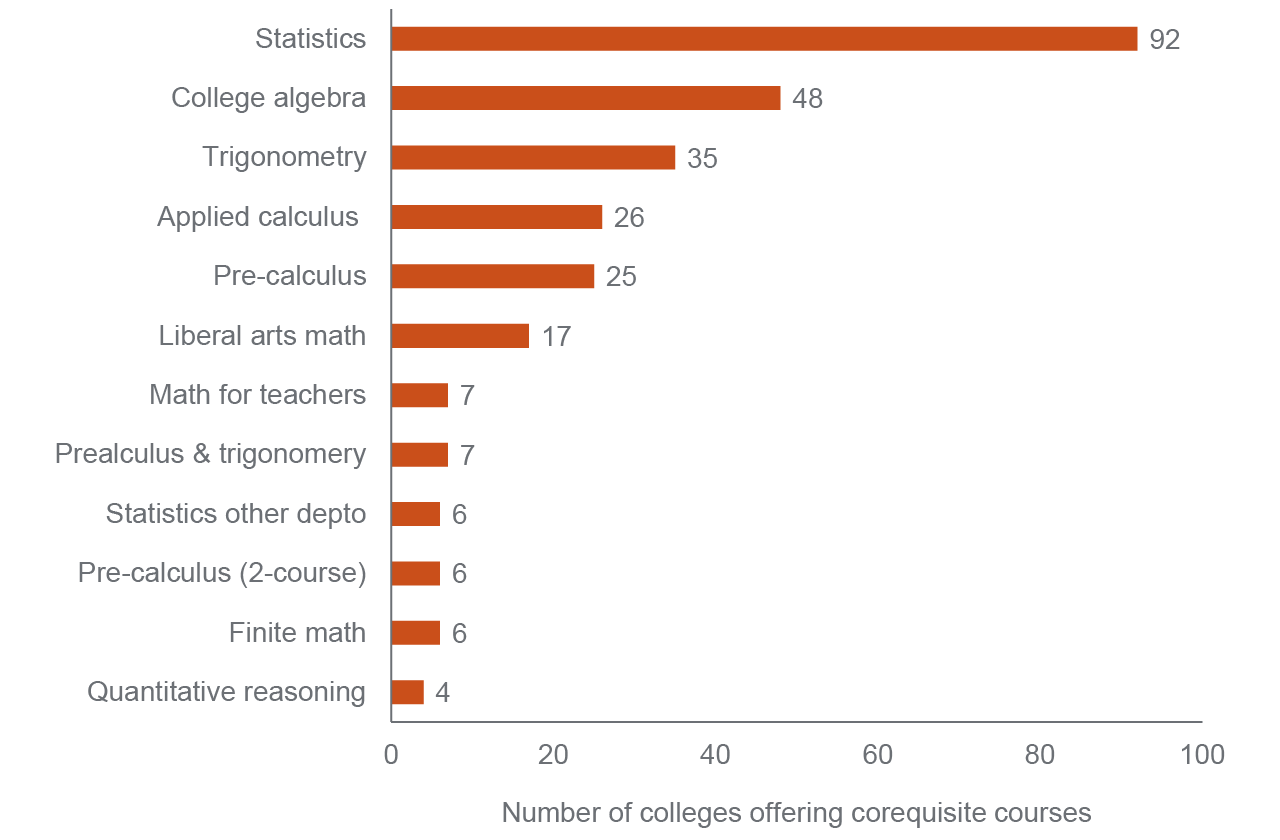
SOURCE: Authors’ calculations using MIS data.
NOTE: Fall of 2020. Out of 114 colleges. One college was excluded because their data for fall 2020 was not available in the MIS.
In terms of student demand, if we look only at colleges that offered corequisite support in a given subject, the prevalence of first-time math enrollment in corequisite courses is higher in pre-calculus (40% of students), liberal arts math (38%), and trigonometry (37%). Relative to fall 2019, a higher proportion of first-time pre-calculus and liberal arts math students took the course with corequisite support in fall 2020 (about 3 percentage points more). In contrast, 30 percent of first-time math students whose first course was college algebra took the course with corequisite support in fall 2020, four percentage points less than the fall 2019 cohort (see Technical Appendix Figure B6).
Successful Completion of Transfer-Level Math Increased
During the pandemic, the share of students successfully completing transfer-level math was actually higher than the previous year: in 2019, 40 percent of first-time math takers successfully completed a transfer-level course in one term, while 46 percent did so in 2020. This increase might be due to students who were less likely to complete a math course opting not to take one.
To test this hypothesis we look for major changes in the characteristics of first-time math students in fall 2020 versus fall 2019. We find that a slightly higher share of first-time math students in the 2020 cohort were female, white, and continuing students. On average, these students have higher completion rates than their peers. However, the average non-math GPA (our proxy of academic performance) was practically the same for both cohorts.
By racial/ethnic groups, we find that 10 percent more white, first-time math students in the fall 2020 cohort successfully completed a transfer-level math course in one term relative to the fall 2019 cohort. Black and Latino students had 1 percent and 3 percent higher successful completions, respectively. But because the number of first-time math takers dropped 12 percent for Latino students and rose 2 percent for white students, the one-term throughput rate for Latinos was 6 percentage points higher in 2020 than in 2019 (38.6% vs. 33.1%), and for white students it was 4 percentage points higher (53.3% vs. 49.6%). See Technical Appendix Table B6 for more details.
COVID-19 has also affected outcomes for the fall 2019 cohort (Figure 6). The share who successfully completed a transfer-level course within one year but not in their first attempt (blue bin) and those who successfully completed the next fall (gray bin) fell slightly compared to earlier cohorts. This was mainly because persistence into the spring and fall terms among students who were not successful on their first attempt or who started in a BTL course fell 4 and 8 percentage points, respectively.
About half of first-time math students in the fall 2019 cohort successfully completed a transfer-level math course within a year
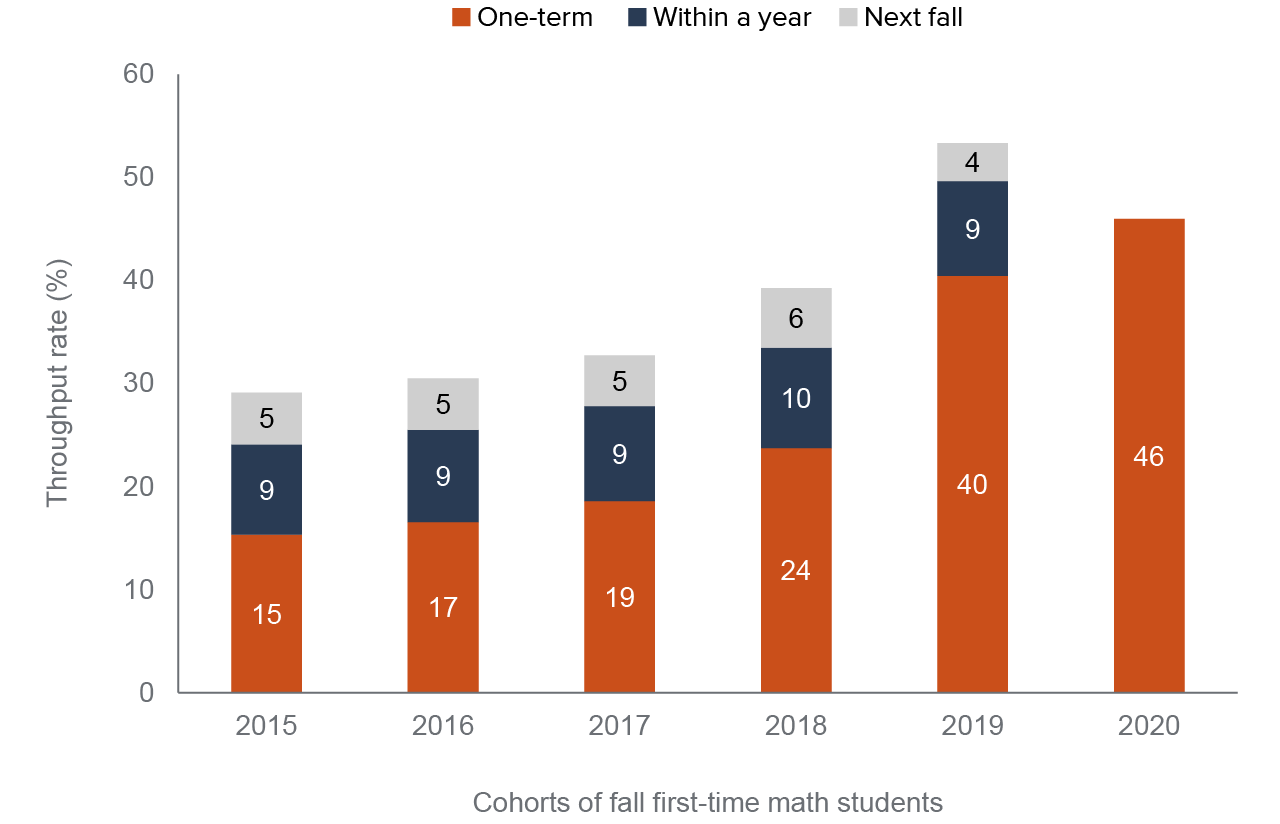
SOURCE: Authors’ calculations using MIS data.
NOTE: Only the first term is available for the fall 2020 cohort.
Among first-time math students who started directly into transfer-level, the success rate increased from 51 percent in 2019 to 57 percent in 2020. This was a generalized trend across the system. Seven colleges had increases more than two times the systemwide increase. However, there were also colleges where results were less encouraging: at 22 colleges the rate of successful completions fell. In 8 of these colleges, the drop was 7 percentage points or higher (see Technical Appendix Table B5).
A higher share of fall 2020 students received As and Bs than fall 2019
To assist students during the March 2020 transition to online learning due to the COVID-19 pandemic, the Chancellor’s Office enacted policy changes to ensure that students were not penalized academically or financially for withdrawing from classes due to COVID-19. Students were allowed to use an “excused withdrawal” at any time if they could not continue in the course because of the pandemic, and using it would not affect a student’s academic progress, academic probation, or ability to repeat a course. The use of excused withdrawal in fall 2020 varied across colleges. In a quarter of colleges, students did not use excused withdrawal, and in 40 colleges students using excused withdrawals represented 10 percent or less of first-time students who did not successfully complete the course. However, in a group of 11 colleges students with excused withdrawals made up 50 percent or more of unsuccessful completions.
When we compare the letter grade distribution of first-time math students in fall 2019 versus fall 2020 (Figure 7) we see a higher share of students earning As and Bs and a slightly lower share earning Cs in fall 2020. It seems likely that students who used excused withdrawal were those who would have been more likely to withdraw or fail if not for the policy change. Indeed, we find that a significantly lower share of these students had a non-math GPA above 3.0 in their first term relative to the students who received any other letter grade (36% vs. 58%). As a comparison, a similar share of students who did not successfully complete the course in fall 2019 (i.e., who earned Ds, Fs, and Ws) had a non-math GPA above 3.0 (33%). Moreover, if we look at first-time math takers who were not in their first term in the community college, we find that a lower share of those who used excused withdrawal had an accumulated GPA above 3.0 in the terms prior to the term of their first math course (63% vs. 77%).
Some Colleges Still Require or Allow Students to Enroll in BTL Courses
In this section, we analyze enrollments and outcomes for BTL courses. We highlight which students are most likely to start in these courses, and compare their early outcomes with outcomes of students who (a) started in a transfer-level course and did not successfully complete it on their first attempt, and (b) started in a transfer-level course with corequisite support.
Twenty percent of first-time math students in fall 2020 started in a BTL course
One in five first-time math students in fall 2020 started in a BTL course (about 25,000 students). However, this rate masks important variation across colleges (see Figure 8). For example, at 23 colleges 32 percent or more of their first-time math students started in a BTL course. Meanwhile, in 25 colleges only 9 percent or fewer first-time students did so. At 5 colleges—Pasadena City, Porterville, Reedley, Sequoias, and Victor Valley—no students started in a BTL course. It is important to highlight that even though some students who place into transfer-level courses may elect to enroll in BTL courses instead, in the aggregate, student enrollment reflects local placement practices and is therefore a good proxy of the level of access into transfer-level courses by the institution.
What are the outcomes for students who start in BTL courses?
The chances of completing a transfer-level course are low for those who first start in a BTL course. Only a third of these students subsequently enrolled in a transfer-level course and only a fifth successfully completed it as of the next fall (Figure 9).
Few students who start in a BTL course successfully complete a transfer-level course by next fall
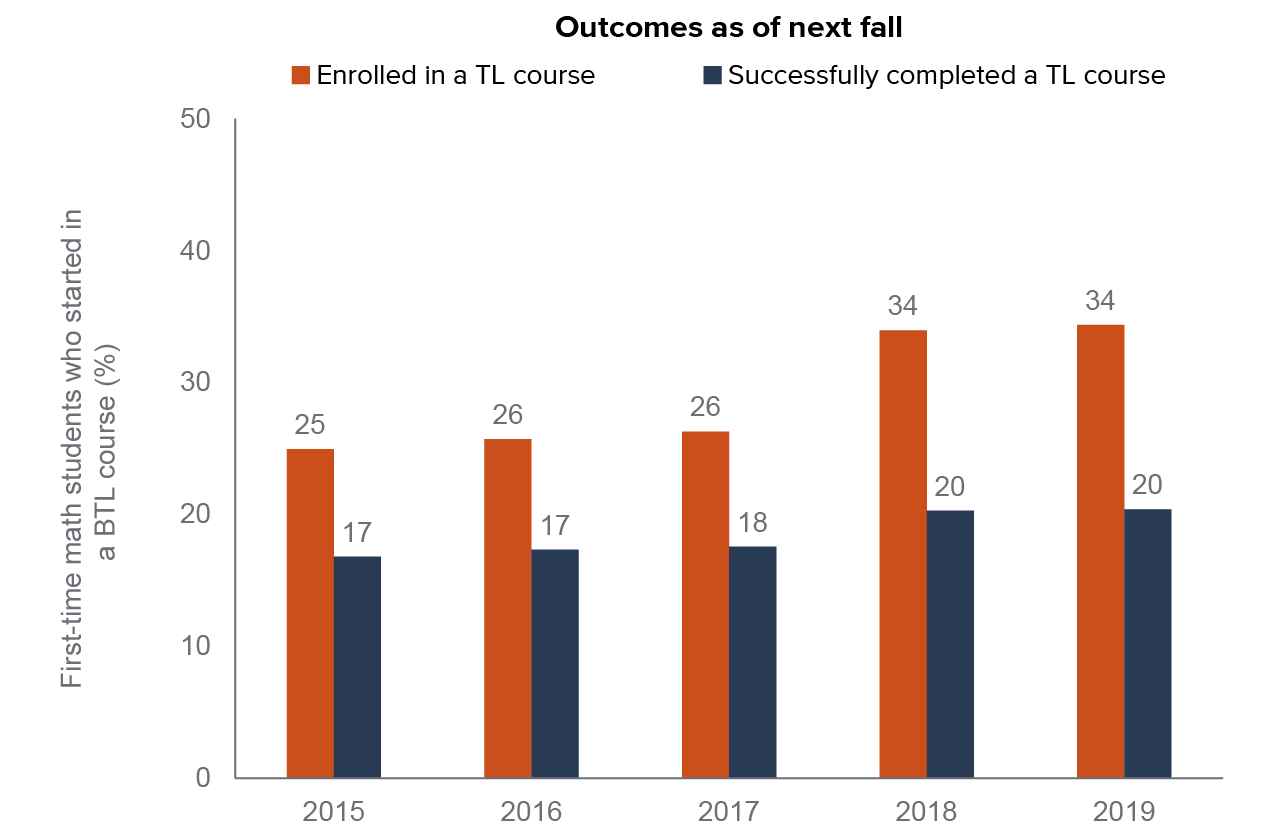
SOURCE: Authors’ calculations using MIS data.
NOTES: Fall of each year. Restricted to students with a transfer goal. For reference, there were 62,500 students in the 2018 cohort who started in a BTL course and 18,800 students in the 2019 cohort. See Technical Appendix Figure B9 for a version of this figure for students who started in a transfer-level course but did not successfully complete in their first attempt.
These rates are significantly below successful completion for students who started in a transfer-level course with corequisite support. Indeed, the share of first-time math students who started in a corequisite model and successfully completed a transfer-level course by the next fall is 31 percentage points higher than the share of students who started in a BTL course and successfully completed a transfer-level course by the next fall (Figure 10).
Moreover, fall-to-fall throughput rates for students who started in a transfer-level course but did not successfully complete it on the first try are 7 percentage points higher than for students who started in a BTL course. While BTL students have higher success rates if they enroll in a transfer-level course than “unsuccessful transfer-level students” (59% vs. 54%), their likelihood of enrolling is significantly lower (34% vs. 48%), which drives the difference in the fall-to-fall throughput rate. If we further disaggregate students who did not succeed on their first attempt between those who started with corequisite support and those who did not, the gap between those with corequisite support and BTL students is narrower (3 percentage points) but it is still statistically significant.
On average, when students start directly in a transfer-level course, they have better chances of successfully completing—even if they do not pass on their first try—than if they start in a BTL course. Of course, starting in a transfer-level course and failing is not a desirable outcome either: a failing grade on the student’s transcript could hurt financial aid, scholarship opportunities, and transfer ability.
Starting in a TL course gives students the best chances of successfully completing it
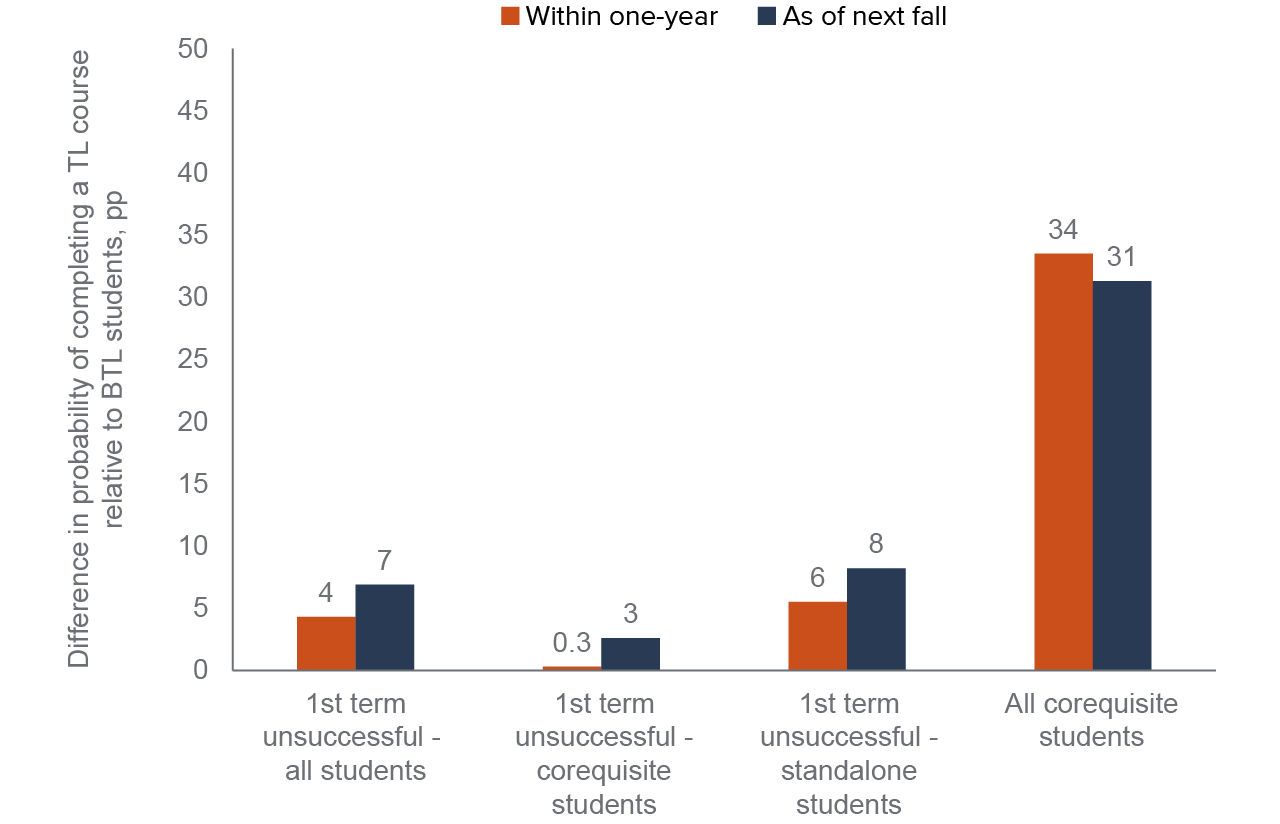
SOURCE: Authors’ calculations using MIS data.
NOTES: Fall 2019 cohort. pp is percentage points. Restricted to students with a transfer goal. Regression adjusted probability of successfully completing a transfer-level course within two time frames. All coefficients but the ”0.3” are statistically significant. See Technical Appendix Table B9 for full regression estimates.
These results are consistent with estimates that control for high school GPA and the highest level of math the student completed in high school. In a recent report, the RP Group finds that students who entered directly into a transfer-level math course were 6.7 times more likely to complete a gateway math class in their first year than were students who started in Intermediate Algebra. This finding was true for all students, regardless of their highest level of high school math completed or program of study.
Why do colleges continue to allow or require students to enroll in BTL courses?
Some college staff and faculty believe it is important to continue offering BTL courses (Rodriguez, Cuellar Mejia and Johnson 2018; Cuellar Mejia, Rodriguez, Johnson 2019; Cuellar Mejia, Rodriguez, and Johnson 2020). Their reasons include serving students whose goal is not transferring to a four-year institution; non-traditional-age students who have been out of school for a while; students wanting to pursue a BSTEM major but who did not successfully complete Algebra 2 in high school; and special populations (i.e., students with disabilities, foster youth, EOPS students, veterans). However, our analyses find that many students in BTL courses do not appear to fall into these categories:
- Transfer-intending students still constitute the majority of students in BTL courses. Sixty percent of first-time math students who started in a BTL course in fall 2020 stated a transfer goal. This share is 8 percentage points below the share before AB 705 implementation, but still remains very high. While the number of first-time students starting in BTL courses fell dramatically after colleges implemented AB 705, thousands of students—most of them transfer-intending—still enroll in these courses (Figure 11).
- Non-traditional-age students (25 years and older) are indeed overrepresented among first-time math students starting in BTL courses. They constitute 25 percent of students who started in BTL courses and 10 percent of students who started in a transfer-level course in fall 2020 (19% and 8%, respectively, if we restrict our sample to students with a transfer goal). However, in our statistical models, we find that non-traditional-age students who start in a transfer-level course are 9 percentage points more likely than younger students to successfully complete the course (see Technical Appendix Table B12). In light of this result, the fact that non-traditional-age students are more likely to end up in a BTL course calls for further examination, especially considering that these students are also more likely to be placed through guided placement.
- Students pursuing non-BSTEM majors make up 68 percent of students who started in a BTL course in fall 2019. Moreover, 68 percent of these students did not enroll in a transfer-level course as of the following fall, and 25 percent enrolled in a SLAM course (Figure 12). Students pursuing BSTEM majors, whom some colleges argue could benefit greatly from BTL enrollment, make up less than one-third of students who started in a BTL course. Only 26 percent of these students enrolled in an algebra-based course as of the next fall and 16 percent successfully completed the course.
Indeed, a recent report by the RP Group finds that students who are pursuing a STEM program of study have much greater throughput when allowed to start directly in a transfer-level math course regardless of their level of math progression in the high school. Even those STEM-oriented students who had only successfully completed Algebra 1 in high school had a much higher throughput rate (38%) when allowed direct access a transfer-level course than those who began in Intermediate Algebra (12%).
The majority of students starting in BTL courses stated a transfer goal
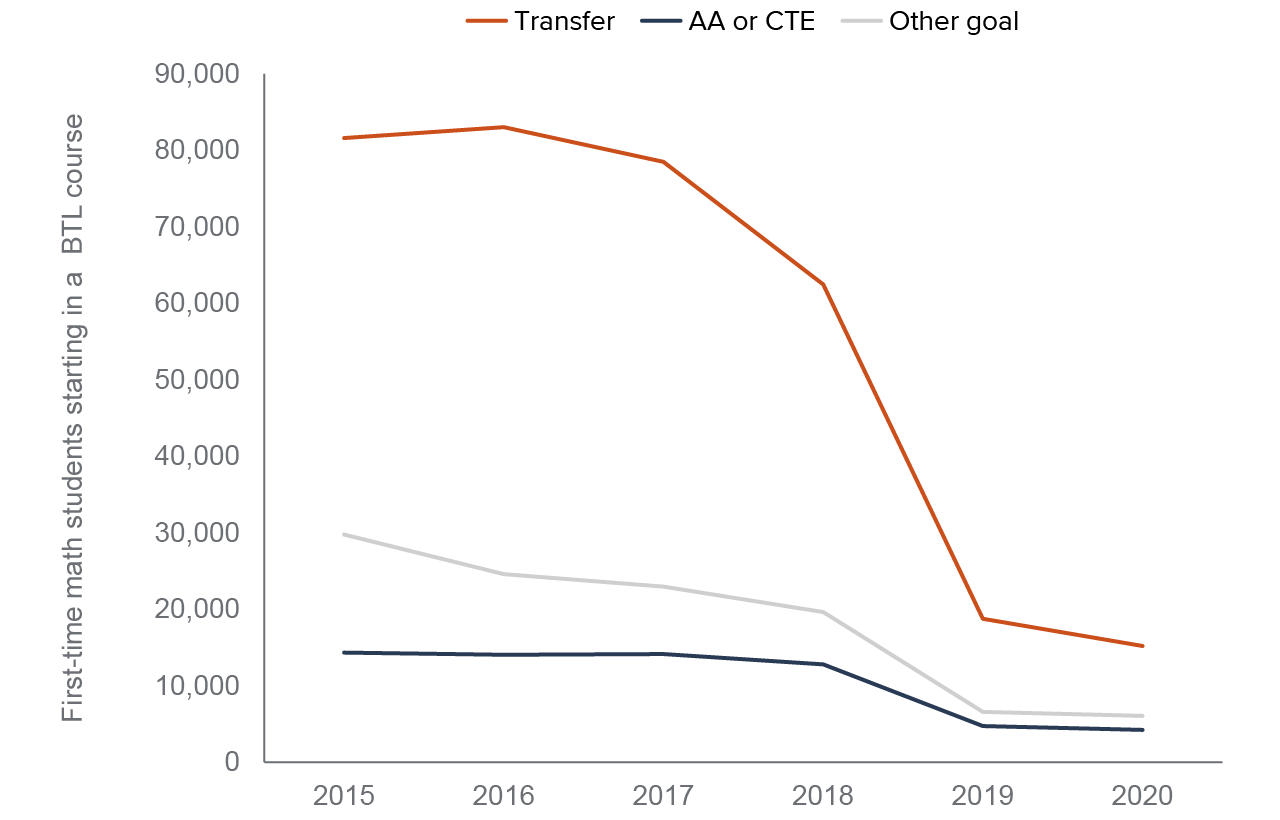
SOURCE: Authors’ calculations using MIS data.
NOTES: Fall cohorts of first-time math students. Other goal includes undecided students, four-year college students taking courses to meet university requirements, complete credits for high school diploma or GED, enrichment, skills building.
Only about a quarter of BSTEM majors who started in a BTL course ended up enrolling in a BSTEM course
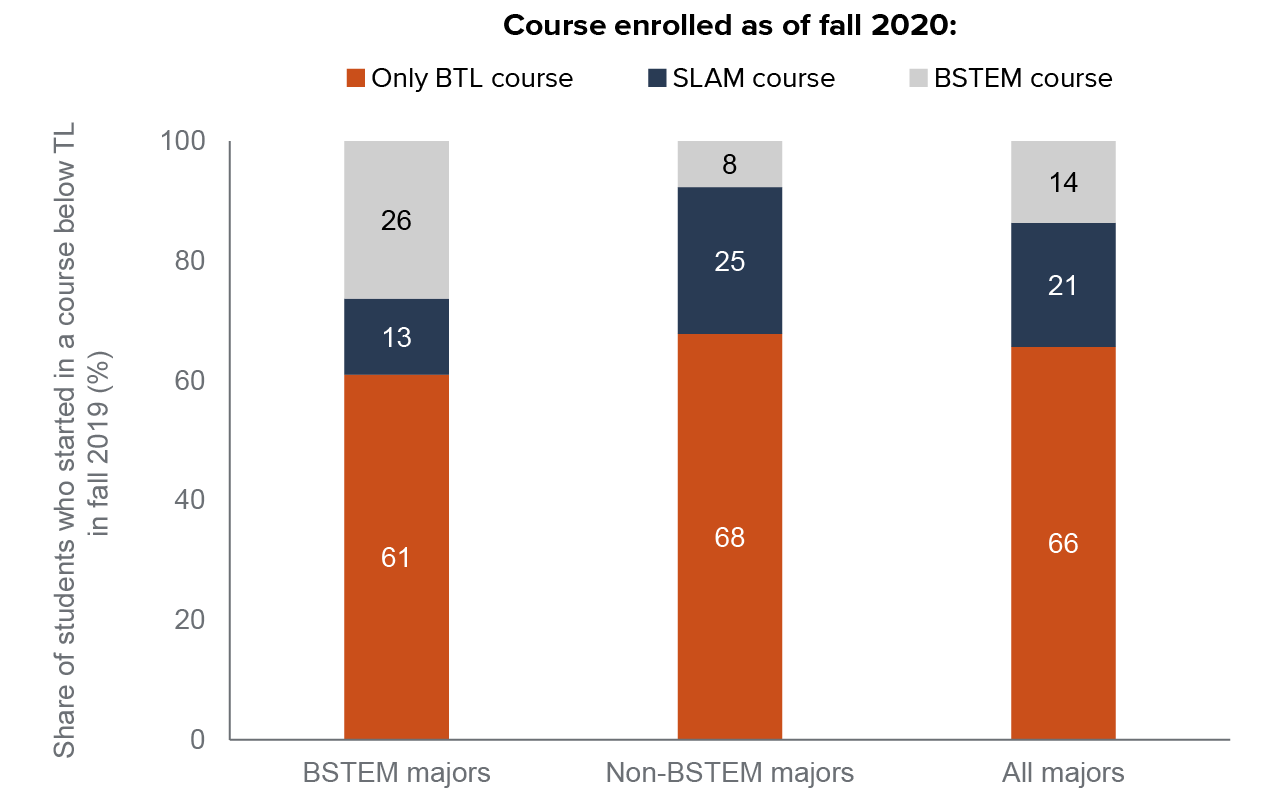
SOURCE: Authors’ calculations using MIS data.
NOTES: Fall 2019 cohort followed through fall 2020. Only students who declared a transfer goal are included (18,751 students). All colleges included. 12,740 students were pursuing non-BSTEM majors and 6,011 were pursuing BSTEM majors. BSTEM majors include business administration, biology, computer science, engineering, mathematics, chemistry, economics, physics, and architecture, among others.
Who is more likely to end up in BTL courses?
Latino and Black students constitute a higher share of first-time math students at colleges with lower access to transfer-level courses. In the 23 lower-access colleges, 54 percent of first-time math students were Latino and 6 percent were Black; these shares are 7 and 2 percentage points higher than the share of these groups at the higher-access colleges (Figure 13).
According to a recent report by the California Acceleration Project, Latino and Black students also disproportionately attend colleges that have maintained high shares of standalone, remedial course offerings. Moreover, the vast majority of colleges serving large populations of Black students (or over 2,000 students) have continued to offer more remedial sections than corequisite-supported transfer-level sections (Hern, Snell, and Henson 2020).
Overall, Latino and Black students are more likely than their Asian peers to start in a BTL course, and so are students with disabilities, non-traditional-age students, California Promise Program/Pell Grant recipients, and limited-English-proficiency students. However, their likelihood of starting in a BTL course is much higher at lower-access colleges than in higher-access colleges (Figure 14). In other words, when access to transfer-level courses is restricted or discouraged, marginalized groups are more heavily impacted by this deficit approach to placement and enrollment.
For example, in lower-access colleges, both non-traditional-age students and students with disabilities are more likely than their peers to end up in BTL courses, by 14 and 18 percentage points, respectively. Meanwhile, in higher-access colleges, they are only 4 percentage points more likely. Notably, for the 2018 cohort at the same group of colleges, non-traditional-age students and students with disabilities in lower-access colleges were less likely to start in BTL courses than in higher-access colleges. This result provides evidence that what we are seeing is not driven by pre-AB 705 trends.
Even though students with disabilities are less likely to succeed compared to non-participants in disabled student programs and services, the gap is relatively small (6 percentage points), which raises questions around why these students are so much more likely to be placed into BTL courses (see Technical Appendix Table B12). To put things into perspective, white students are about 5 percentage points less likely to succeed in transfer math than are Asian students, but they are far less likely to start in BTL courses than students with disabilities.
Some marginalized groups are more likely to end up in BTL courses, and significantly more so at “lower-access” colleges
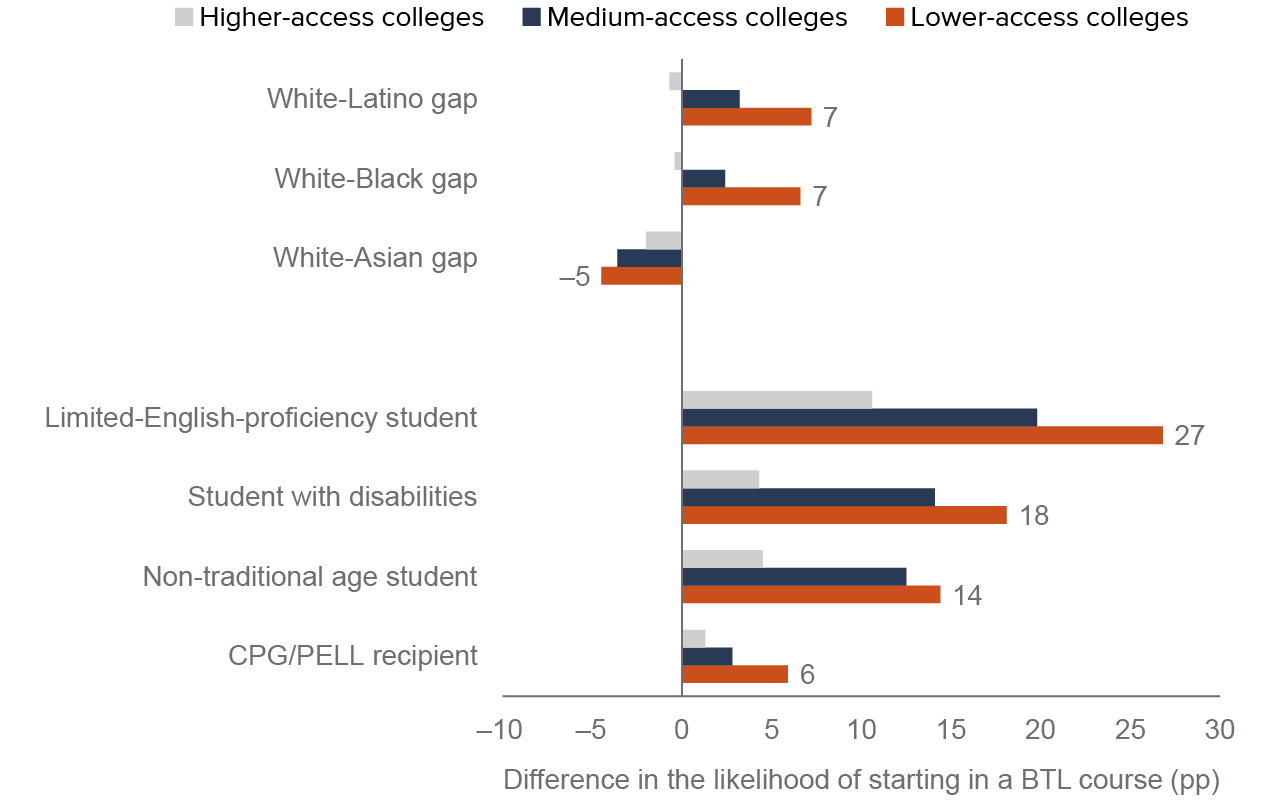
SOURCE: Authors’ calculations using MIS data.
NOTES: Results for the fall 2019 cohort. pp is percentage point. The white-Latino gap represents the difference in the likelihood of starting in a BTL course between white students and Latino students; while in lower-access colleges the gap is 7 percentage points, in higher-access colleges there is no gap. The white-Latino gap and the white-Black gap are not statistically significant in higher-access colleges. For the other variables, the comparison group is all students who are not in the category. Higher-access colleges are colleges with access rates one standard deviation above the system wide average (i.e., 91% or higher) while lower-access colleges have access rates one standard deviation below (i.e., 68% or lower). Medium-access colleges are colleges where the share of first-time math students starting directly in a transfer-level course is between 68 percent and 91 percent. Average marginal effects from probit models, the dependent variable is 1 if the students started in a BTL course and we control for various student characteristics including grade point average, excluding math courses as a proxy of academic strength. See Technical Appendix Table B11 for the full regression estimates.
AB 705 and the BSTEM Path
After California passed AB 705, some faculty expressed concern that the reform might negatively affect the volume and diversity of students who successfully complete or make progress in BSTEM pathways. Success in Calculus I or Applied Calculus—gateway courses to many BSTEM disciplines—is critical for students who want to pursue careers in these fields. To examine what actually happened with AB 705 implementation, we look at the progress made by students in the fall 2019 cohort towards calculus completion. But before moving on with these results, it is worth noting that:
- The proportion of students who intend to major in BSTEM fields has gone up slightly. In fall 2019, 36 percent of first-time math students who intended to transfer were pursuing a major in a BSTEM field (about 37,200 students). This proportion is slightly higher than in pre-AB 705 cohorts (34% for the fall 2018 cohort and 31% for the 2017 cohort).
- BSTEM students are now more likely to take a math course that is appropriate for their intended major. Most students (57%) pursuing a major in a BSTEM field started in an algebra-based transfer-level course (i.e., calculus, applied calculus, pre-calculus, trigonometry, college algebra, and finite math). Meanwhile, 27 percent started in a SLAM course and 16 percent in a BTL course. This is a big shift relative to fall 2018, when only 38 percent of BSTEM students started in an algebra-based transfer-level course, 15 percent in a SLAM course, and 47 percent in a BTL course.
More Students Had Access to and Completed a Calculus Course
Close to 6,500 first-time math, transfer-intending students who were pursuing a major in a BSTEM field started directly in Calculus I or Applied Calculus in fall 2019, 19 percent more than in fall 2018. Of these students, 4,050 (or 62%) successfully completed the course in that first term.
However, in most colleges, students must complete a sequence of two transfer-level courses (commonly pre-calculus and trigonometry) before enrolling in Calculus I. Few colleges have only one transfer-level pre-requisite to Calculus I, usually a course that combines both pre-calculus and trigonometry into a single course. Likewise, some colleges allow students who have completed Algebra 2 in high school to access Applied Calculus while others have one transfer-level pre-requisite, usually college algebra.
To determine how many students made tangible progress towards calculus completion, we followed students in the fall 2019 cohort who were pursuing major in BSTEM fields for three main terms—so it was technically possible that a student taking two prerequisite courses could have completed Calculus I/Applied Calculus in fall 2020.
The likelihood that a student successfully completed Calculus I/Applied Calculus varied depending on the student’s starting course (Figure 15). For example, only 15 percent of students who started in college algebra and 20 percent of students who started in trigonometry in fall 2019 successfully completed Calculus I or Applied Calculus as of fall 2020. In comparison, students who started in a pre-calculus course were almost twice as likely to complete. Students who started in the combined pre-calculus and trigonometry course had slightly higher completion rates than students who started in the regular pre-calculus course (38% vs. 35%). Not surprisingly, the chances of a student successfully completing went up significantly for those who started directly in Calculus I or Applied Calculus, 78 percent and 64 percent, respectively.
In all, 9,500 first-time math students in the fall 2019 cohort successfully completed a Calculus I (7,835 students) or Applied Calculus (1,709 students) course as of fall 2020. This rate is 22 percent higher than for the fall 2018 cohort. These results mean that about one in four first-time students pursuing a BSTEM major reached this important milestone towards their academic goal in our period of analysis.
The likelihood of successfully completing Calculus I or Applied Calculus varies depending on students starting course
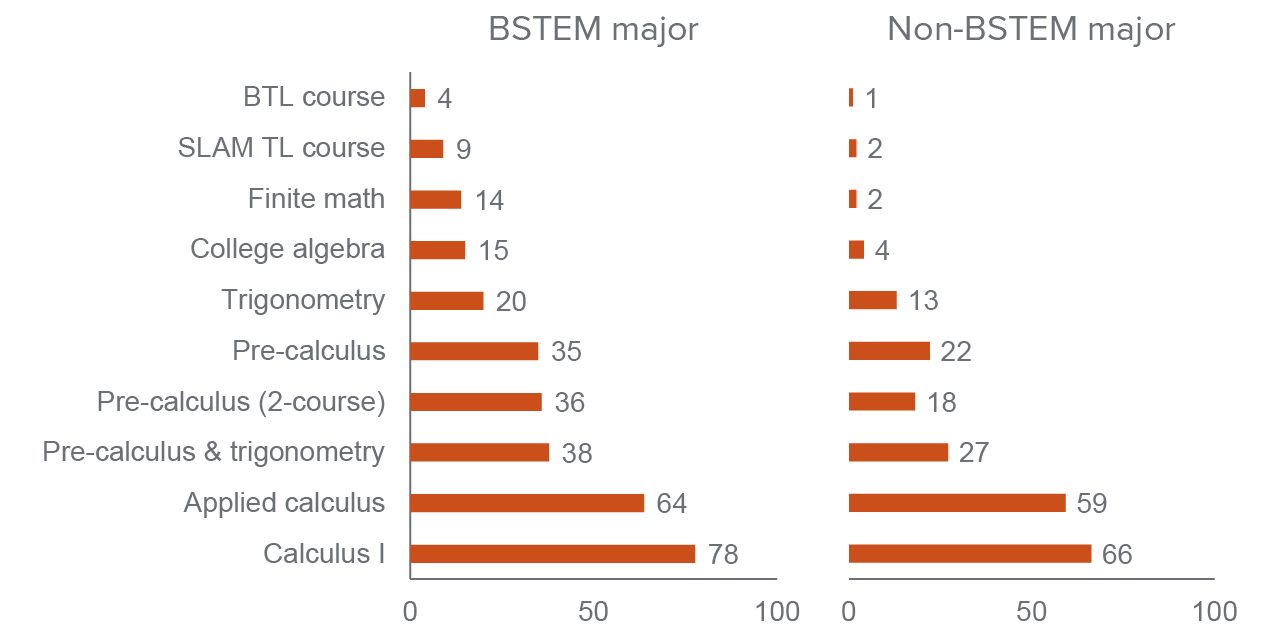
SOURCE: Authors’ calculations using MIS data.
NOTE: Share of first-time math students in the fall 2019 cohort who successfully completed Calculus I or Applied Calculus as of fall 2020 by BSTEM majors (9,544 students) and non-BSTEM majors (3,378 students). Analysis restricted to students with a transfer goal. See Technical Appendix A for details about which majors were coded as BSTEM.
But what happened to the rest of students? Some students started in a transfer-level course but did not successfully complete it in their first term, which makes the three-term time frame for Calculus completion less realistic. If we focus on those first-time students in the fall 2019 cohort who were pursuing majors in BSTEM fields and successfully completed an algebra-based transfer-level course in their first term but did not complete Calculus I or Applied Calculus as of fall 2020, 68 percent enrolled in another algebra BSTEM course and 39 percent successfully completed one as of fall 2020. These are slightly lower rates than in fall 2018 (3 and 4 percentage points lower), but not a big difference considering the pandemic’s effect on community college enrollments in fall 2020, especially in BSTEM courses. Despite the lower rates, 32 percent more students progressed along the BSTEM pipeline in the fall 2019 cohort than in the fall 2018 cohort. Importantly, these may be lower-bound estimates; as instruction resumes in person, gains will be likely larger.
In all, we are seeing that the number of students taking and competing transfer-level BSTEM math courses has increased. However there is still a lot of work to do to effectively support students so more direct access into transfer-level courses in the BSTEM path translates into successful completions.
Racial Equity Gains in Subsequent Course Enrollment and Completion for BSTEM
Given that student and college characteristics may affect the above findings, we next explore how results change when we control for these factors. After AB 705, all students are more likely to enroll in a subsequent math course, by 1.6 percentage points, and they are more likely to successfully complete one, by 1.2 percentage points, compared to pre-reform trends (Figure 16).
Looking only at students who declared a BSTEM major, these estimates nearly double. BSTEM majors are 2.4 percentage points more likely to enroll in, and 1.9 percentage points more likely to successfully complete a subsequent math course by the next spring. Tracking these two outcomes through the next fall term, estimates remain statistically significant and increase slightly (see Technical Appendix Table D2).
Across racial/ethnic groups, students of color saw the most notable gains in both enrollment and success in subsequent math courses, compared to pre-reform trends. Specifically, both Latino and Black BSTEM students see statistically significant gains in subsequent course enrollment (2.9 percentage points) and successful completion (2.4 percentage points) in the next spring, compared to pre-reform (Figure 16). For Asian students, the gains are also statistically significant but slightly lower in magnitude (see Technical Appendix Table D5). At the same time, we also find that white students do not see any significant gains post-AB 705.
BSTEM students, and students of color specifically, see biggest boost in subsequent math course enrollment and success post-AB 705
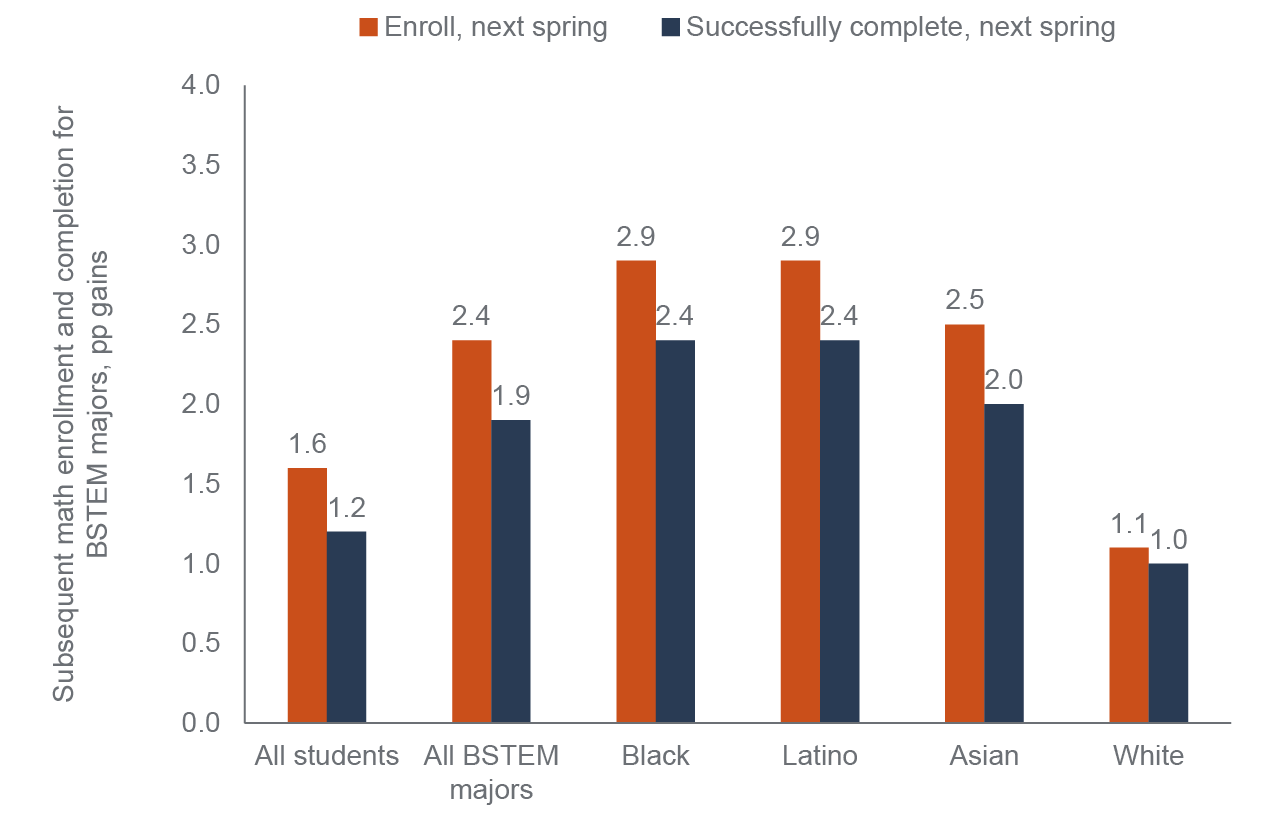
SOURCE: Authors’ calculations using MIS data.
NOTES: pp stands for percentage points. Restricted to students with a transfer goal and no previous college degree. Estimates presented are for the impact of AB 705 in the fully specified interrupted time series model that includes controls for the reform, time trend, student demographic and academic characteristics, college characteristics, and college fixed effects. Estimates in this figure are statistically significant for all students, all BSTEM majors, and Black and Latino students. Estimates are not statistically significant for Asian and white students. See Technical Appendix D for details on empirical strategy and model specifications. Regression estimates for enrolling and completing in the next spring and fall are presented in Technical Appendix Table D2. See Technical Appendix Table D3 for Wald chi-squared tests (SUEST) of significance across racial/ethnic groups.
In summary, AB 705 has helped boost BSTEM math pathway success for students of color, a promising finding given the historical underrepresentation of Latino and Black students in BSTEM majors. National evidence also suggests that community college students who complete gateway and higher-level math in the first year are more likely to persist in STEM programs (Chen 2013). However, for this early promise to materialize into truly diversifying the BSTEM pipeline, students must have the necessary supports and services to ensure they succeed in BSTEM-major courses beyond math.
Reducing Racial and Ethnic Gaps in Success
Despite the profound transformation that has transpired under AB 705, there is still a long road ahead to eliminate racial equity gaps in successful completion of transfer-lever math courses.
Our interviews with math faculty shed light on what they perceive as key elements and strategies that can help address racial and ethnic gaps in student learning and success. We also provide insights specific to corequisite remediation, one strategy math departments have increasingly adopted in an effort to enhance learning environments and help students transition to transfer-level coursework.
Key Elements of Equity-Minded Reform
A consensus among our interviewees was that equity-minded reform within math classrooms and departments requires coordination, communication, and collaboration. Instructors and support staff can build on such elements to provide students with the support and resources they need to succeed.
Institutional support and strong leadership. Campus-wide discussions on equity have increased significantly since the implementation of AB 705 and have amplified since the start of the pandemic, as staff and faculty have had to collaborate on how to best support students gaining unprecedented access to transfer-level courses. However, equity conversations among math departments appear to occur at a smaller scale. Half of the math faculty members we interviewed highlighted the need for leadership to organize and promote such discussions more broadly within their departments.
Proactive leaders have embedded equity conversations into mandatory trainings, provided monetary incentives for faculty to attend workshops, and emphasized equity-mindedness in the hiring process. About one in four math faculty members suggested that where departments embrace such training and professional development, student success seems to follow. At one college, specialized training for SLAM faculty coincided with higher success in transfer-level statistics courses, even with a significant increase in enrollment.
Staff training centered on equity. Math faculty shared that stringent course content and learning objectives, especially in BSTEM, make it difficult to mold courses and infuse equity-based content into their syllabus, in effect limiting their options for making math more accessible and relatable. At the same time, math faculty manage non-content and non-cognitive related difficulties—such as stereotype threat, math anxiety, and educational trauma—that impose unique challenges for students.
Instructors and support staff need accessible and effective training that equips them with appropriate information and strategies to address racial equity gaps inside and outside of the classroom. The Racial Equity in Mathematics Leadership Institute, organized by Bensimon & Associates and the USC Race and Equity Center, is one example. Noting that the potential of AB 705 as an equity-focused reform depends greatly on instructors who are committed to racial justice, some of the topics covered in this institute included:
- cultivating an awareness of race and racism and its manifestations in the math classroom;
- practicing race consciousness in an affirmative sense when interpreting data;
- taking responsibility for “seeing” classroom practices as racialized and taking corrective action; and
- taking the actions necessary to dismantle practices that perpetuate racial gaps in course outcomes.
Efforts like these should be expanded by integrating staff, faculty, and administrators at all levels to ensure that new placement policies and classroom level reforms are actually effective.
Curricular and Support Strategies
Math faculty varied in their proposed and practiced strategies to implement reform within classrooms. At the core of their strategies, however, is a shared goal to effectively address the needs of all students.
Designing student-centered classroom structures. According to 61 percent of math faculty members, enhancing student learning requires a student-centered classroom design that emphasizes engagement, collaboration, and community-building. Though it is more complex in math, many faculty members emphasized the need for engaging group work and active learning as an alternative to strictly lecture-based courses. Additionally, some shared that they have adopted a constructivist approach to their classroom, where students participate as contributors to the creation of knowledge. In such classrooms, the role of the instructor becomes less that of a lecturer and more that of a facilitator, taking into account their students’ diverse backgrounds and prior knowledge to help them connect new course content with their existing ideas and experiences.
As co-constructors of knowledge, students can take ownership of their learning and contribute to the learning of the class by expanding on material with their own perspectives and insights. Such approaches can build trust within the classroom, increase student participation and agency, and reduce math anxiety that may limit progress. In some cases, these approaches seem to work better in corequisite or enhanced course models where instructors benefit from additional class time to incorporate more group and relationship-building activities. In fact, two faculty members cited that student feedback from corequisite models frequently identifies group work as an important feature affecting their success in the course.
Implementing equity-minded classroom practices. Math faculty are also incorporating equity-based approaches to combat persistent success gaps and discouragement among underrepresented and disadvantaged students, with some embedding culturally relevant topics into class assignments, readings, and assessments. Altering course syllabi is seemingly more common in SLAM courses due to more flexible course content.
For example, two instructors shared ways in which they incorporated mental health and loan repayment modules into their statistics courses; students could then study and present on topics relevant to them and build confidence in their mastery by using tools applicable to their situations. In BSTEM courses, faculty have found it more challenging to contextualize course content. Still, some faculty are rethinking the calculus sequence to incorporate more data analysis, and reimagining the curriculum to reflect how students can apply math, technology, and modeling in the real world.
Student success can also be cultivated through a compassionate classroom design that emphasizes positive reinforcement, the affective domain, and open communication. Some math faculty members that we interviewed (39%) stressed the importance of developing welcoming and accessible syllabi that outline clear expectations and ensure students that their roles as co-constructors of knowledge are crucial to the success of the class. The importance of inclusivity and trust cannot be understated, as students’ perceptions of how their professor thinks about them and their ability to succeed can dramatically affect their performance and growth (Staats et al. 2017).
Reevaluating grading and assessment. Over three in four (78%) math faculty have embraced, or hope to implement, some form of equity-based grading, citing work from Joe Feldman and other researchers as influencing their approach to assessing student outcomes. Such an approach focuses on grading methods that are accurate and value knowledge, embrace a growth mindset and transparency, and support intrinsic motivation.
To reinforce a growth mindset, some faculty members have embraced flexibility in their grading policies, incorporating more flexible due dates, accepting late work, and allowing test retakes. Others have begun to rethink assessments and student learning objectives, and reexamine what it means for a student to be successful in their course. Such faculty have embraced non-test-based competency, including a reliance on more group projects and presentations, and on new assessments that emphasize critical thinking, problem solving, and active participation.
Some instructors have also sought to expand opportunities for student feedback and input into their assessment process in order to support intrinsic motivation, going as far as to incorporate a sort of contract-grading approach to their class. In this approach, instructors collaborate with students to develop a grading contract that outlines expectations and assignments of specific quality that correspond to subsequent letter grades or assessment outcomes. Though diverse in nature, these approaches were identified by faculty as having the potential to improve student success by addressing the inequities of traditional grading methods, many of which may disadvantage students with different backgrounds, skills, and academic preparation.
Enhancing academic supports. Enhanced classroom supports ensure that students’ academic needs are fully met, especially those that cannot be effectively addressed by a single instructor. Colleges are providing such supports in a variety of ways.
At Porterville College, which has completely eliminated BTL courses, Peer Assisted Study Session leaders act as supplemental TAs for courses in which they previously succeeded, while math mentors provide more general mentorship and guidance for all math students.
At other colleges, embedded tutors provide instructors, especially in corequisite courses, much needed instructional support within their classrooms. Supplemental Instruction (SI) and zero-unit or non-credit courses provide students with additional avenues to access academic support outside of the classroom. Such academic supports, including tutoring, counseling, and mentoring, should be expanded, prioritized, and in some cases individualized, to enhance student learning and support instructors who often are asked to wear many hats.
How Corequisite Remediation Supports Equity
As corequisite offerings continue to increase across the community college system, further insights, from students, faculty, and researchers alike, will be crucial to better understanding how additional class time can be optimized to effectively enhance student learning and reduce racial equity gaps. Recent research, including our own quantitative analyses, highlighted in Technical Appendix E, finds mixed evidence on the effectiveness of math corequisites (Ran and Lin 2019; Logue et al. 2016, 2019).
Below we use findings from our interviews with math faculty to help explain why this variation in success might occur, what strategies seem to work for certain instructors, and what can be done to further improve learning environments and increase success outside of the corequisite model.
Effective use of additional class time. Currently, math instructors are utilizing corequisite course time in a variety of ways. According to more than half (56%) of our interviewees, effective corequisite courses rethink the classroom experience by providing just-in-time remediation and emphasizing the affective domain and equitable pedagogy. Considering that students taking corequisite courses tend to have lower math preparation and may experience math anxiety, using the extra time to infuse community-building activities and creating a sense of belonging among students becomes especially important in these courses. Four math faculty members shared that extended class time has also facilitated a slower course pace, allowing students additional time to catch up and master difficult concepts.
Though not uniform across all colleges and courses, corequisites in SLAM tend to incorporate more affective domain activities and culturally relevant content, while in BSTEM, they are more likely to be used as extra review time that may sometimes look and feel like a traditional remedial math course. The stringent nature of BSTEM syllabi and course sequences make it difficult to shift time away from the skills-based course content. However, BSTEM courses can still be transformed.
In fact, at Citrus College, the math department completely redesigned their corequisite classrooms by transforming a once lecture-based class into a course focused on active learning and collaboration by adding whiteboards on every wall and collaborative furniture. According to a Citrus math instructor, these physical changes to the pre-calculus classroom, along with using the extra time to set a positive foundation with an early emphasis on the affective domain, have played a crucial role in increasing success rates in subsequent calculus courses.
Instructor training and support. Staff training and support centered on equity seems to be key to early success with corequisite remediation. Such training ensures that instructors have the necessary resources to optimize their additional class time to meet the diverse needs of students. Additionally, they provide opportunities to raise awareness of prevalent obstacles such as math anxiety and implicit biases, which may hinder student success in math and may be especially present in corequisite courses, which tend to be reserved for students with relatively low math preparation.
Disparities in corequisite success rates across colleges may be attributed in some form to such wide variation between how colleges and math departments require and provide training to support the implementation of more equitable classroom policies and practices. Among the colleges in our interview sample, where math departments and faculty have been proactive in restructuring classrooms, embedding equitable-minded pedagogy and policies and institutionalizing course structures and expectations, corequisite courses seem to be most effective in improving student outcomes.
Alternative support models and strategies. While corequisite success stories are not uncommon, they are not a catchall solution. Several faculty members and counselors expressed concerns that students who may need additional support but are not placed in corequisite courses or choose not to enroll in them when recommended are not always provided the necessary academic supports to succeed in transfer-level courses.
An alternative is to provide all students with free additional academic supports without increasing mandatory workloads. Some colleges have implemented zero-unit or non-credit support courses, which provide structured spaces for optional course review and tutoring. Other colleges have relied more on enhanced course models, increasing units for all standalone courses as opposed to creating separately linked corequisites—a model used successfully by College of the Siskiyous. Faculty also noted that embedded tutors in corequisite and standalone courses offer crucial instructional and tutoring support, relieving instructors from having to address student needs alone.
Though our interviewees were mixed in their confidence in corequisite models, they all agreed that student supports need to be improved to effectively close racial equity gaps. Given the mixed evidence on corequisite remediation, future research must examine corequisite models and alternative approaches with the goal of learning how they can be best utilized to improve equitable student outcomes.
Caveats and Limitations
- The accuracy of our results relies on the accuracy with which colleges report their information to the Chancellor’s Office. While we used various approaches to identify colleges with inconsistent data, it is possible that we missed colleges where the data discrepancies were not stark.
- The MIS database does not include data on placement, so we are unable to identify who was referred to developmental education or to transfer-level with or without corequisite support. Neither do we have information on students’ high school performance measures (i.e., course-taking, grades, or GPA). As a result, our analysis is based exclusively on course-taking behavior.
- A critical question is whether students who start in transfer-level courses with corequisite support have better outcomes than those who start in traditional developmental sequences. Since we do not have high school records or assessment and placement information, we cannot directly assess whether prior academic preparedness drives our results. We further discuss this limitation in our analysis of corequisite courses in Technical Appendix E.
- Our focus in Technical Appendix E is on corequisite models because we are not yet able to consistently identify and measure participation in other forms of concurrent support (e.g., writing labs, tutoring centers, supplemental instruction).
- Our ITS analysis is limited to only one cohort post-AB 705. Unfortunately, cohorts entering after spring 2020 were impacted by the COVID-19 pandemic and any results after that term cannot be interpreted as causal.
- The analysis of persistence and success in subsequent courses for the 2019 cohort is impacted by the pandemic and therefore its results should be interpreted with caution.
Conclusion and Recommendations
Our research affirms that AB 705 has been transformative for students at California’s community colleges. Thanks in large part to AB 705, the barrier long posed by lengthy remedial sequences is nearly gone at most colleges across the state. Even so, challenges and opportunities remain for helping support and sustain students toward equitable math course outcomes. To inform efforts to improve student success and promote more equitable outcomes, we offer the following set of recommendations.
- Enroll transfer-intending students into transfer-level courses, with or without support, by default. Our research adds to growing evidence that suggests direct enrollment into transfer-level courses better supports student success in math (Cuellar Mejia et al. 2020; Meiselman and Schudde 2021; Logue et al. 2016, 2019; Ran and Lin 2019).
Enrolling in BTL courses does not benefit most students (Hayward 2021). Even students who started in a transfer-level math course and did not successfully complete it are more likely to complete transfer-level math later on than students who start in BTL courses.
Students in corequisite courses have higher chances of completing a gateway math course compared to BTL students. However, in examining outcomes of corequisite and standalone gateway math students we found no conclusive evidence that corequisite courses improve successful completion of transfer-level math. Corequisites should therefore target students with the lowest math skills, while those on the margin of needing additional support might be better served by being given direct access. In both cases, access to standalone transfer-level math courses is the main driver of in successful completion of transfer-level courses.
To target students for courses appropriately, counselors, advisors, and faculty could work together to ensure a common understanding of course offerings and placement policies. Only students who could benefit from extra corequisite support should be placed there, and there must be sufficient courses to meet the demand. Finally, math faculty and counseling teams should work to ensure that students know of and can access available academic and student support services.
- Automatically opt transfer-intending students who are not pursuing BSTEM majors into the appropriate transfer-level math course. The relatively high share of non-BSTEM majors—and Latino and Black students specifically—who enroll in BTL courses is cause for concern. There is evidence that this group of students would be more successful if enrolled in a statistics or a liberal arts math course, with or without support. By offering open access to intermediate algebra courses and pre-statistics courses, colleges inadvertently drive up BTL enrollments. Enrolling these majors into a statistics or a liberal arts math course, with or without support, leads to more completions.
Placing these majors in a transfer-level SLAM course, with or without support, would help maximize the likelihood of successful course completion and it agrees with the Guided Pathways goal of aligning math pathways with students’ program of study. Colleges can also clarify placement policies and messaging in public documents (e.g., course sequence charts, placement website, catalog). Counselors and advisors should meet with students to explain the different math pathways and ensure students enroll in the transfer-level course most appropriate to their degree goals. Math faculty and counselors should also work together to increase corequisite SLAM courses and promote student and academic supports that foster success in gateway math courses. Non-BSTEM students who want to take the traditional math sequence could opt out of the SLAM course.
- Identify strategies that ameliorated the impact of the pandemic and adapt them for a face-to-face environment. While the pandemic brought forth many adverse social, economic, and health impacts, our work also sheds light on how changes that colleges made in response to the pandemic—especially those associated with online learning and institutional and instructor flexibility—can support student success. Indeed, we find that student outcomes were not affected as negatively as originally feared, with more students earning As and Bs in fall 2020 compared to fall 2019.
Interviews with community college stakeholders revealed that the transition to online learning expanded and enhanced online student supports—like tutoring, counseling, and mental health services. In online courses, faculty used more video lectures, which allowed students to learn at their own pace. Math faculty we interviewed noted that the ability to pause, rewind, and review material was especially helpful for concepts that are more difficult to grasp in a live class environment. Access to tutoring services beyond traditional business hours was also cited as very helpful.
Instructors and colleges adopted flexibility around policy and practice during the pandemic (e.g., grading flexibility, excused withdrawals) that further supported student success. Together with expanded use of food pantries and online mental health services, these strategies illuminate how colleges help more students succeed when they support the whole student.
Moving forward, colleges should work to continue and enhance flexibilities and online supports after courses resume mostly face-to-face. Research should identify which of these strategies are most effective at meeting students’ needs and improving student outcomes.
- Strengthen efforts to improve messaging and coordination between math departments and counseling. Through our interviews, we learned that some students who take BTL math courses are influenced by the information and guidance they receive. But the evidence shows that the likelihood of a student successfully completing transfer-level math is greatly reduced if they begin in a BTL course.
Given the many pathways and course options available to students at the CCC, counseling and advising may have the most impact around math courses. Our interviewees noted that messaging around placement and math pathways is often a challenge, but the messaging is crucial to help students make informed choices for their major and their first math course. Students should be told that their likelihood of eventually passing a transfer-level course is much higher if they start at the transfer level. Colleges can strengthen messaging by limiting remedial course offerings, engaging counselors in redesigning course sequences and informational materials, and offering mandatory orientations that provide guidance on math and major pathways.
- Support Black and Latino success in BSTEM pathways beyond introductory math coursework. With AB 705, more students enrolled in and completed BSTEM math courses—gains were noteworthy for Latino and Black students, who have been historically underrepresented in BSTEM majors. Eliminating the standardized placement test and reforming developmental math structures also had direct benefits on diversifying BSTEM math pathways.
Moving forward, colleges, community college districts, and the Chancellor’s Office should work together to support students in other core major courses (e.g., physics, chemistry, engineering, computer science, business) beyond gateway math to maintain this momentum through graduation and transfer. The work on Guided Pathways can help support these efforts, as can special programs aimed at supporting underrepresented students in STEM.
Programs like the federally funded Palomar College STEM program, which aim to support STEM pathways through outreach, counseling, academic supports, and guaranteed admissions to CSU San Marcos, are a good example of how intersegmental collaborations could support these efforts. Ensuring that such programs are sustainable, centered on equity, and done at scale, not just pilots, will be key. Making sure the BSTEM pathway remains viable is crucial, as research has found that BSTEM majors have the highest returns and potential for economic mobility, but Latino and Black students have historically been underrepresented (Johnson and Cuellar Mejia 2020).
- Establish a longitudinal student database for researchers to assess the effectiveness of corequisite remediation. Prior math coursework and high school GPA cutoffs are the primary determinants of whether students are placed into corequisite courses, which makes the current gap in student data critical. With longitudinal data researchers could also examine other student supports and outcomes beyond college, including labor market participation and returns, which appear to be especially important post-pandemic.
A longitudinal data system would allow researchers to inform efforts to help ensure equitable access and success in math, better track student’s outcomes in college and beyond, and identify successful programs and math pathways that serve historically underrepresented students more effectively. The California legislature and the governor support establishing a longitudinal database and efforts are already underway to establish a data system that connects K–12, higher education, workforce, and social services data (Jackson 2021).
Topics
Access Equity Higher Education K–12 EducationLearn More

A New Era of Student Access at California’s Community Colleges

Community College English in California’s New Era of Student Access

Ensuring All Students Benefit from Landmark Community College Reform
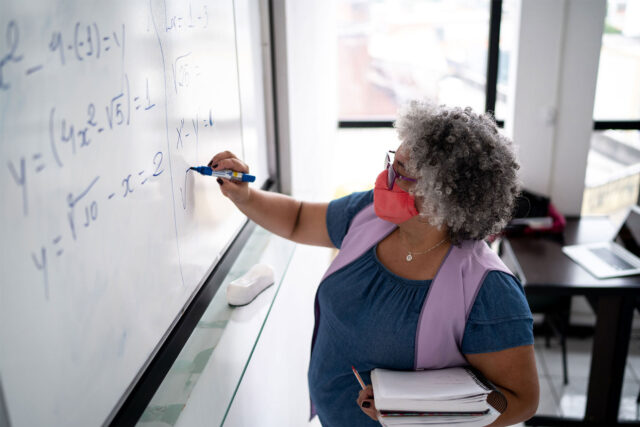
Mapping Equitable Access to Math at California’s Community Colleges

Video: Community College Math in California’s New Era of Student Access




